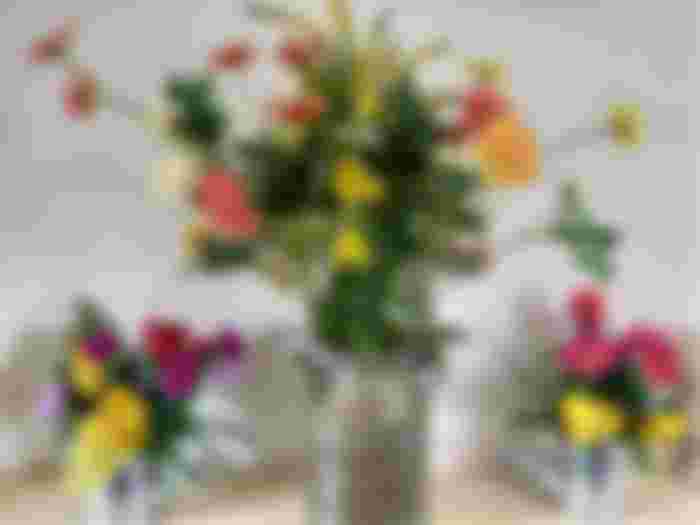The habit of enjoying the beauty of flowers has been common in all places and times. Since the ancient days, people have decorated their rooms with beautiful flowers arranged in vases, placed blossoms in their hair, or simply held bouquets in their hands. The love of flowers is very natural to us humans.
In Japan, however, certain ways of arranging flowers in vases were refined to a peak of artistic beauty. It was a time of the battle in the Muromachi Period (1338-1573) that gave birth to this gentle art known today as ikebana.
Technically, Kado and Ikebana are the same. However, "kado" refers not only to the artistry of the flowers but also requires manners, techniques, mental and physical techniques as well. Therefore Kado's work is referred to as "Ikebana Flower Arranging". And the specialists of the way of the Kado are called "Kadoka" or flower masters.
Deities and flowers
In Japan, it is their long been custom to offer flowers to the souls of the dead. Even in the Bon Festival of today, a Buddhist event to welcome the souls of ancestors on their annual visit to this world, people place flowers picked in the fields or mountains on special shelves in front of the entrance to the house as offerings to the souls of their ancestors.
This custom of offering flowers to the souls of the dead predated the entry of Buddhism into Japan. As a result of their research, some folklorists believe that the ancient Japanese held the simple belief that flowering plants have a kind of vital spirit. When the spirit is active, the plants come into flower; when it is at rest, the flowers fade and fall. Folklorists further presume that the ancient Japanese believed that they could awaken the souls of the dead, which had been quietly asleep, by offering them flowers with a vital spirit.
The Nobles' Art
The Japanese people's sense of the seasons has been closely intertwined with their lives since ancient days. With this background, the Japanese came to have strong feelings for specific symbols of the seasons, such as snow (yuki), the moon (tsuki) and flowers (hana). New words were made by adding the suffix mi (seeing) to these words and Japanese have enjoyed viewing snow scenes of snowy days (yuki-mi), admired the beauty of the moon on nights when it is full (tsuki-mi), and enjoyed seeing flowers and blossoms at their best (hana-mi). These objects symbolic of the seasons were not necessarily viewed individually. People usually gathered together to enjoy this beautiful thing of nature, and, in time, they came to gather not only to admire but to feast as well. Especially among the nobles of the aristocratic age, banquets for viewing snow, the moon and flowers were popular. Court nobles, including the emperor, often went out to enjoy places renowned for their beauty.
Flowers in Chinese Historical Drama
That scene will be familiar to you if you are watching Chinese Historical Drama. In China, the lotus flower represents a person with integrity. While Plum flowers are said to be the embodiment of a person's strength and perseverance. This flower blossom in early spring, late winter, often when it's snowing. But despite the harsh environmental condition, the flower blooms. This is used often as a metaphor for someone's ability and integrity to face hardships with courage.
I remember watching "Empresses in the Palace" when Zhen Huan recites a plum flower poem that capture the emperor's heart.

And how each of them in the palace has their own favourite flowers that they look after in their palace.
Another example from Empresses in the Palace is Shen Meizhuanglove for chrysanthemum saying, she likes chrysanthemum for its characters which again capture the heart of the Emperor.
Chrysanthemum blooms in autumn when all the other flowers have withered, being away from the competition. Chinese scholars considered chrysanthemum as a loner and have one's own merit that is independent of the world's impression.

I was browsing a flower catalogue that came by mail today and enjoys the beauty of the flowers and how they are arranged in the vase, I'm so amazed. This one we got the last time. It's a Sunny Marigold Arrangement in Mini Milk Churn.

I'm always fascinated by flowers and captivated by their beauty. I love how the Japanese and the Chinese teach us many styles and flower arrangement. And how each of us loves to grow, pick our flowers and arrange them in a way it pleases us.
Flowers indeed can make us smile with their beauty and admire their characters. Their lovely scent can captivate one's heart and fall in love with it. It's a great stress reliever!
No wonder men give us flowers.
Thank you for reading.





i love watching this on yt 😅 there's satisfaction in how they have to delicately cut the stems in the ikebana practice